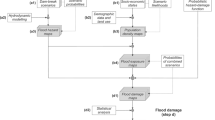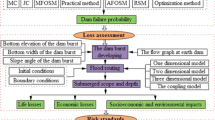Abstract
Several empirical methods based on the relationship between historical dam failure events and the number of casualty are available for estimating the loss of human lives resulting from dam failure. However, none of the empirical methods can seamlessly predict the number of casualties caused by a dam failure, because the characteristics of dam breach flood, warning time, human response to the warning, understanding of flood severity, and other factors necessary for calculating the number of life loss are not understood clearly. Therefore, the number of life loss predicted by the empirical methods is subjective to uncertainty. Uncertainties in the predicted number of life loss due to dam breach flood are identified in this study by performing uncertainty analyses regarding the dam breach flood routing analysis results and life loss estimations. The uncertainty analyses are conducted using the Monte Carlo simulation based on the Latin Hypercube Sampling technique, and computational programs are developed to carry out the uncertainty analyses. Considerable degree of uncertainty in the predicted number of life loss as well as dam breach flood routing results is revealed through the uncertainty analyses and presented comparatively with the modified boxplots.
Similar content being viewed by others
References
Bohn, M.P., Whleer, T.A., and Parry, G.W. (1988).Approaches to uncertainty analysis in probabilistic risk assessment, NUREG/CR-4836, SAND 87-0871, U.S.A.
Bowles, D.S. (2000). “Advances in the practice and use of portfolio risk assessment.”Proceedings of the 2000 Australian Committee on Large Dams (ANCOLD) Annual Meeting, Cairns, Queensland, Australia.
Brown, C.A. and W.J. Graham (1988). “Assessing the threat to life from dam failure”,water Resources Bulletin, Vol. 24, No. 6, pp. 1303–1309.
Charles Yoe (1992). “Quantitative risk assessment and technology transfer: Software developments.”Risk-based decision making in water resources V, ASCE, pp. 92–107.
DeKay, M.L. and G.H. McClelland (1993). “Predicting loss of life in cases of dam failure and flash flood”,Risk Analysis, Vol. 13, No. 2, pp. 193–205.
Federal Energy Regulatory Commission (1991).Engineering guidelines for evaluation of hydropower projects, Office of Hydropower Licensing, Washington, D.C., U.S.A.
Fread, D.L. (1981). “Some limitations of dam break flood routing models.”ASCE Fall Convention, St. Louis, MO, U.S.A., p. 15.
Fread, D.L. (1984).DAMBRK: The NWS Dam-Break Flood Forecasting Model, National Weather Service (NWS), Maryland, U.S.A.
Froehlich, D.C. (1995). “Embankment dam breach parameters revisited”,ASCE Conference on Water Resources Engineering, San Antonio, TX, U.S.A.
Graham, W.J. (1999).A procedure for estimating loss of life caused by dam failure, DSO-99-06, Dam Safety Office, U.S. Bureau of Reclamation Safety, Denver, CO, U.S.A.
Høeg, K. (1996). “Performance evaluation, safety assessment and risk analysis for dams.”Hydropower and Dams, Issue 6, pp. 51–58.
Iman, R.L. and W.J. Conover (1980),Small sample sensitivity analysis techniques for computer models, with an application to risk assessment, Communications in Statistics, Part A, Theory and Methods, pp. 1749–1842.
Jarrett, R.D. (1984), “Hydraulics of high gradient streams”,J. of hydraulic engineering, ASCE, Vol. 10, NO. 11, pp. 1519–1539.
Karl, M.D. (1998). “Risk analysis of a seepage/piping dam safety issue”,Managing the risks of dam project development, safety and operation: Eighteenth annual USCOLD lecture series, Buffalo, NY, U.S.A.
Kung C.S. and Yang X.L. (1993).Dam-break flood simulation and river parameter uncertainty, Royal Institute of technology, Stockholm, Sweden.
Loh, W.L. (1987). “On Latin Hypercube Sampling”,Annals of Statistics, pp. 2058–2080.
Morgan, M.G. and Henrion, M. (1990).Uncertainty: A guide to dealing with uncertainty in quantitative risk and policy analysis, Cambridge university press, NY, U.S.A.
Moore, D.S. and McCabe, G.P. (1993).Introduction to the practice of statistics, W.H. Freeman and Company, NY, U.S.A.
National Weather Service (1998).National Weather Service FLDWAV MODEL, Version 1.0, Hydrologic research laboratory, Office of hydrology, National Weather Service (NWS), NOAA.
Palisade Corporation (1996).Guide to using @Risk. Risk analysis and simulation add-in for Microsoft Excel or Lotus 1-2-3, Newfield, NY, U.S.A.
RAC Engineers & Economists and U.S. Army Corps of Engineers (1999).Alamo Dam Demonstration Risk Assessment: Summary Report (Draft report), Los Angeles District, LA, U.S.A.
Stein, M. (1987). “Large sample properties of simulations using Latin Hypercube Sampling”,Technometrics, pp. 143–151.
U.S. Army Corps of Engineers (1986),General report flood emergency plan for Alamo Dam, Los Angeles District, LA, U.S.A.
U.S. Army Corps of Engineers (1992).Guidelines for risk and uncertainty analysis in water resources planning, Volume II. IWR Report 92-R-2, U.S.A.
Vick, S. and Stewart, R. (1996), “Risk analysis in dam safety practice, Uncertainty in the geologic environment: From theory to practice.”Geotechnical Special Publication, ASCE, No. 58, pp. 586–603.
Von Thun, Lawrence, J., and Gillette, D.R. (1990). “Guidance on breach parameters”, Unpublished manuscript, p. 15.
Wahl, T.L. (1998). Prediction ofembankment dam breach parameters: A literature review and needs assessment, DSO-98-004, U.S. Bureau of Reclamation, U.S.A.
Author information
Authors and Affiliations
Additional information
The manuscript for this paper was submitted for review on September 30, 2002.
Rights and permissions
About this article
Cite this article
Lee, JS. Uncertainties in the predicted number of life loss due to the dam breach floods. KSCE J Civ Eng 7, 81–91 (2003). https://doi.org/10.1007/BF02841991
Issue Date:
DOI: https://doi.org/10.1007/BF02841991




